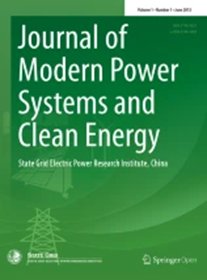Energy Equity-Constrained Tie-Line Scheduling Model in Interconnected Systems
IF 6.1
1区 工程技术
Q1 ENGINEERING, ELECTRICAL & ELECTRONIC
Journal of Modern Power Systems and Clean Energy
Pub Date : 2024-11-19
DOI:10.35833/MPCE.2024.000529
引用次数: 0
Abstract
Energy equity refers to the condition in which access to the cleaner energy required by individuals is equally available to all. To relieve the energy expenditures - the key component in the concept of energy equity - of low-income communities, governments worldwide have imposed caps on soaring energy prices. However, the inherent mechanisms within the operational schedule remain undiscussed. This paper innovatively provides guidelines for operators to embed energy burden policies into the bulk power system model, by answering two critical questions. ① What is the impact on system price pattern when embedding the locational price constraints? ② How to reformulate the tie-line schedule to meet the equity thresholds? Consequently, a novel bi-level energy equity-constrained tie-line scheduling model is proposed. The conventional economic dispatch is solved at the upper level, and then a preliminary operational schedule is given to the lower level, where we propose an energy equity slackness component variable to evaluate the gap between preliminary and desired equity-satisfied operational schedules. The implicit constraints on the price are converted into explicit feasibility cuts with dual theory. Case studies on test systems demonstrate the reduced energy expenditure for underserved communities, and the optimal tie-line schedule is also validated.互联系统中能源权益约束的联络线调度模型
能源公平是指所有人都能平等地获得个人所需的清洁能源。为了减轻低收入社区的能源支出(能源公平概念的关键组成部分),世界各国政府对飙升的能源价格实施了限制。但是,业务时间表内的内在机制仍未讨论。通过回答两个关键问题,本文创新性地为运营商将能源负担政策嵌入大容量电力系统模型提供了指导方针。当嵌入区位价格约束时,对系统价格模式有什么影响?②如何重新制定配线时间表以满足股权门槛?在此基础上,提出了一种新的双能级能源权益约束的并线调度模型。首先在上层解决常规的经济调度问题,然后给出一个初步的运行计划给下层,在下层我们提出一个能源公平松弛分量变量来评估初步的和期望的公平满足的运行计划之间的差距。利用对偶理论将价格的隐式约束转化为显式可行性削减。测试系统的案例研究表明,为服务不足的社区减少了能源消耗,并且也验证了最佳联络线计划。
本文章由计算机程序翻译,如有差异,请以英文原文为准。
求助全文
约1分钟内获得全文
求助全文
来源期刊

Journal of Modern Power Systems and Clean Energy
ENGINEERING, ELECTRICAL & ELECTRONIC-
CiteScore
12.30
自引率
14.30%
发文量
97
审稿时长
13 weeks
期刊介绍:
Journal of Modern Power Systems and Clean Energy (MPCE), commencing from June, 2013, is a newly established, peer-reviewed and quarterly published journal in English. It is the first international power engineering journal originated in mainland China. MPCE publishes original papers, short letters and review articles in the field of modern power systems with focus on smart grid technology and renewable energy integration, etc.
 求助内容:
求助内容: 应助结果提醒方式:
应助结果提醒方式:


